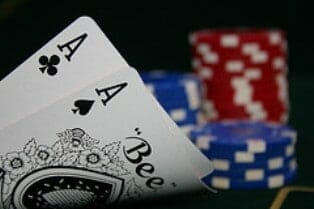How Much Money Do you Need to Buy In for to Play Limit Poker at a Casino?
By Steve Beauregard
Walk by nearly any poker room in any casino in America, and what will you see? Men in sunglasses. Trash talking. Loud whining about bad beats or bad play. Impressive stacks of chips. For a person wanting to try out live poker for the first time, the whole scene can be intimidating. I know it was for me.
And perhaps the biggest misunderstandings of folks who have never played poker in a casino is that you need a lot of money to get into the game.
Nothing could be further from the truth.

For example: the lowest limit Texas Hold’em game offered in most places is $2/4 limit hold’em, in which the maximum bet on the final two rounds of betting is $4. The minimum you would need to be able to sit down at this table is $20. Admit it: you’ve dropped more than that in ten minutes at a Wheel of Fortune machine.
Now, I would never recommend you sit down at a poker table with the minimum buy-in, (we’ll talk about the proper buy-in here in a second), but this $20 example is meant to show you that depending on the limits you play, and how you play, poker may be the cheapest form of gambling in the casino.
(Go here to see the Best Poker Room in Las Vegas For Beginners)
The actual amount of money you will want to have before sitting down to play poker depends on a variety of factors, including your risk tolerance, total gambling bankroll, and skill level, yet by far the most primary factor in deciding how much to buy-in for will depend on what stakes you are playing.
Although it may be a dying breed, limit poker can be found in nearly every casino that has a decent-sized poker room. The limits typically start out at $2/4 limit, but many places (MGM Grand in Las Vegas for example), start off with $3/6 limit. Another low limit is $4/8, which is the lowest limit available at places like the Bellagio’s poker room.
From those lower limits, the various games offered can include $6/12, $8/16, $10/20, $15/30, $20/40, $30/60 on up. The enclosed, high stakes area at “Bobby’s Room” inside the Bellagio Poker Room has been known to host $2,000/4,000 limit games. If you’re reading this article, you probably won’t be playing this game.
How Much Should I Buy In For When Playing $2/4 Limit Poker in a Casino?
Not as prevalent as it was during the poker boom of the 2000’s, $2/4 limit hold’em can still be found around Las Vegas, including at the Quad Resort, the Flamingo, Monte Carlo, and the Excalibur.
While the minimum buy-in for this game is the aforementioned $20, you should sit down with at least 20 big bets on the table, which in this case would be $80. ($4 big bet x 20 big bets).
The reason for this is two-fold: you want a decent-enough stack at the table to be able to ride the temporary up and down swings you’ll commonly experience during the game. It’s pretty demoralizing having to reach into the wallet to pull out more money, time and time again – all in order to have a decent enough stack on the table.
Secondly, you’ll want to have enough chips to go all the way to the river should the betting be capped. Let me explain.
Most limit hold’em games are a 4 cap game, meaning there is a maximum of 4 bets allowed on each round. In other words, after one player bets, there can be a maximum of three raises, making it a total of 4 bets each player would need to put into the pot.
A maximum of 4 bets on each of the four rounds of betting equals 12 big bets total. (You may think it should be 16 big bets, but remember: the first two betting rounds are half the size of the big bet, i.e. $2, rather than the $4 big bet in a $2/4 game).
In our $2/4 example again, four bets before the flop would be $8 total ($2 x 4 bets), followed by another maximum of $8 after the flop. After the turn, the 4 bets, multiplied by the now-higher $4 limit would equal $16 maximum you would have to throw into the pot to keep playing. The same figure ($16) applies to betting after the river.
Thus, in a $2/4 game, the maximum you would ever have to see a showdown is $48. And having the $80 you bought in for (20 big bets) would ensure you are covered should the betting be capped on all four rounds. This scenario is not likely, but I’ve been involved in pots where it was.
The advantage of having enough chips to help cap a pot is that you will maximize your profit should you have the winning hand. If you were to run out of money, you could still win, and would still have a side pot to collect, but there would be money on the table shipped to another player that should have rightfully been yours.
Whether it’s $2/4 limit, $3/6, or higher, the “20x the big bet” standard is a good rule of thumb. In the case of $2/4 limit, I prefer to buy in for $100, which is exactly one rack of white ($1) chips. (As a side note, for those of you who don’t know: a rack has 5 different slots, and each slot holds up to 20 chips each.)
The $100 buy-in equals 25 big bets of course, and this helps give me cushion for the inevitable bad run of cards. It’s also much easier for me to remember how much I bought in for after I’ve had several beers. The same thing applies when I play $4/8 at the Bellagio. Instead of the $160 buy-in (20 big bets x $8), I make it an even $200 for tracking purposes.
So following our 20x big bet guideline, here are the amounts you should buy-in for various limit games. (It’s always OK to buy in for higher amounts too).
$2/4 Limit: $80
$3/6 Limit: $120
$4/8 Limit: $160
$6/12 Limit: $240
$8/16 Limit: $320
$10/20 Limit: $400
$15/30 Limit: $600
$30/60 Limit: $1,200
And I haven’t played any higher than $30/60 at the Ameristar Poker room in Black Hawk, Colorado, so I won’t comment on buy-ins for higher games, other than to say that the 20x rule of thumb would most likely apply to those games as well.
As a side note, for those of you who dream of playing limit poker for a living, many pros operate under the theory that you would need at a poker bankroll of at least 300 big bets (of whichever stakes you play), in order to survive the up and down swings. In other words, having 300 big bets, (or $1,200 in our $2/4 example) would theoretically mean you would always be “in action” and most likely not ever be in a situation where you’ve lost the entire $1,200. This, of course, is assuming you play well.
